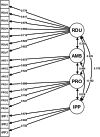Development and validation of a psychometric scale for assessing pharmacy students' perceptions and attitudes toward antimicrobial resistance and antimicrobial stewardship in Indonesia: the PATARAS study
- PMID: 40448097
- PMCID: PMC12125818
- DOI: 10.1186/s12909-025-07375-5
Development and validation of a psychometric scale for assessing pharmacy students' perceptions and attitudes toward antimicrobial resistance and antimicrobial stewardship in Indonesia: the PATARAS study
Abstract
Appropriate perceptions and attitudes of pharmacists toward antimicrobial resistance (AMR) are essential. However, AMR attitudes and perceptions have not been assessed in Indonesia. This study aimed to develop and validate a questionnaire to evaluate pharmacy students' Perceptions and Attitudes toward Antibiotic Resistance and Antimicrobial Stewardship (PATARAS) and investigate the relationship between students' perceptions and attitudes toward antibiotic resistance and stewardship. Using purposive sampling, 500 undergraduate pharmacy students were included in the study. The 20-item PATARAS questionnaire with 5-point Likert scales was developed. The PATARAS includes perception (rational drug use (RDU) and antimicrobial stewardship (AMS)) and attitude (professional role (PRO) and inappropriate practice (IPP)) domains. The validity (convergent and discriminant) of the PATARAS was investigated using confirmatory factor analysis (CFA). The CFA model fit was assessed using various goodness-of-fit indices. Reliability was assessed using Cronbach's alpha (α) and McDonald's Omega (ω) values. The relationship between subdomains was evaluated using structural equation modeling (SEM). The PATARAS questionnaire achieved acceptable convergent and discriminant validity. The CFA model achieved a good fit. The reliability was good with α and ω values of 0.817 and 0.845, respectively. The SEM showed that RDU and AMS were positively correlated with PRO (β = 0.121 and 0.539, respectively, p < 0.05); RDU and IPP were also positively correlated (β = 0.313, p < 0.05), while AMS and IPP were negatively correlated (β = - 0.275, p < 0.05). The PATARAS is a valid and reliable instrument for assessing undergraduate pharmacy students' perceptions and attitudes toward AMR and AMS.
Keywords: Antimicrobial; Attitude; Perception; Pharmacy students; SEM.
© 2025. The Author(s).
Conflict of interest statement
Declarations. Ethics approval and consent to participate: This study was conducted in accordance with the ethical principles of the Declaration of Helsinki, a globally recognized standard for research involving human participants, established by the World Medical Association. This standard outlines guidelines for conducting ethical research, emphasizing respect for individuals, beneficence, and justice. Ethical approval for this study was granted by the Health Research Ethics Committee of Universitas Harapan Bangsa (approval number: B.LPPM-UHB/726/02/2022). This approval ensured that the study design, recruitment, and data handling procedures adhered to established ethical standards for research involving human participants. Consent for participants: Informed consent was obtained from all pharmacy institutions and participants included in this study. An online consent form explained the study's purpose, the voluntary nature of participation, participant anonymity, confidentiality, and data handling procedures, ensuring that all participants were informed about the study’s objectives and implications [56]. Consent for publication: Not applicable. Competing interests: The authors declare no competing interests.
Figures


Similar articles
-
Perceptions and current practices of community pharmacists regarding antimicrobial stewardship in Tasmania.Int J Clin Pharm. 2018 Oct;40(5):1380-1387. doi: 10.1007/s11096-018-0701-1. Epub 2018 Aug 2. Int J Clin Pharm. 2018. PMID: 30069668 Free PMC article.
-
Disability attitudes in healthcare scale: translation and cross-cultural validation into Arabic using various medical samples.Disabil Rehabil. 2025 Apr;47(7):1844-1853. doi: 10.1080/09638288.2024.2385735. Epub 2024 Jul 30. Disabil Rehabil. 2025. PMID: 39078085
-
Knowledge, attitudes, and perceptions about antibiotic use and antimicrobial resistance among final year undergraduate medical and pharmacy students at three universities in East Africa.PLoS One. 2021 May 7;16(5):e0251301. doi: 10.1371/journal.pone.0251301. eCollection 2021. PLoS One. 2021. PMID: 33961678 Free PMC article.
-
A global investigation into antimicrobial knowledge in medicine, pharmacy, nursing, dentistry and veterinary undergraduate students: A scoping review to inform future planetary health multidisciplinary education.BMC Med Educ. 2024 Oct 29;24(1):1227. doi: 10.1186/s12909-024-06253-w. BMC Med Educ. 2024. PMID: 39468598 Free PMC article.
-
[Psychometric characteristics of questionnaires designed to assess the knowledge, perceptions and practices of health care professionals with regards to alcoholic patients].Encephale. 2004 Sep-Oct;30(5):437-46. doi: 10.1016/s0013-7006(04)95458-9. Encephale. 2004. PMID: 15627048 Review. French.
References
-
- Chahine, E. B., El-Lababidi, R. M., & Sourial, M. (2015). Engaging pharmacy students, residents, and fellows in antimicrobial stewardship. Journal of Pharmacy Practice, 28(6). 10.1177/0897190013516506. - PubMed
-
- Zawahir, S., Hettiarachchi, C., & Morrissey, H. (2017). Assessing Knowledge, Perception and Attitudes About Antibiotics Among Final Year Pharmacy Undergraduates in Sri Lanka. International Journal of Pharmacy and Pharmaceutical Sciences, 9(10), 234. 10.22159/ijpps.2017v9i11.21891.
Publication types
MeSH terms
LinkOut - more resources
Full Text Sources
Medical

